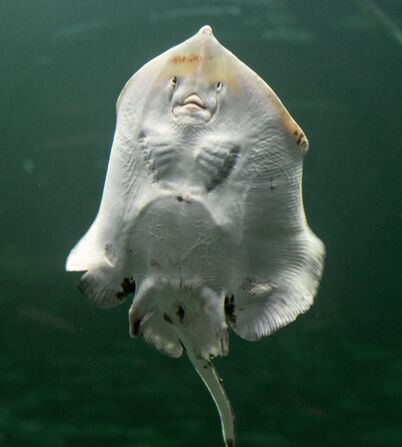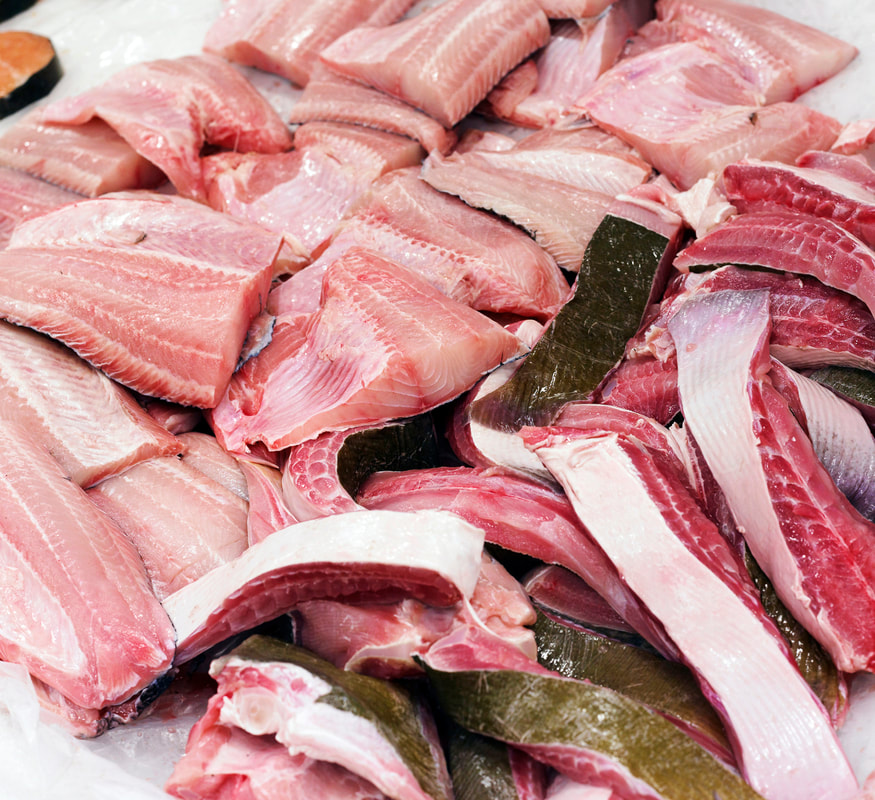There are over 220 species of Stingray
Current Conservation Status For Stingray:
Currently Unknown
SIZEWidth: 10in - 8ft
Weight: 5 - 800 Pounds DIETCrabs, Shrimp, Squid, Wrasse fish, Gobiidae, Clams/Mussels/Oysters/Scallops, Cuttlefish, Snails, Worms, Prawns, Seahorses.
|
LIFESPANWild Lifespan: 15-25 Years
Captive Lifespan: 5-10 Years HABITAT & RANGEAnywhere from coral reefs to muddy riverbeds - Stingrays often inhabit warm temperate and tropical waters, sometimes in great abundance. They are bottom dwellers and often lie partially buried in the shallows
|
Stingray are a relative of sharks and are highly valued as both a food source and for their unique leather, sometimes referred to as "Shagreen".
Is Stingray Leather a By-Product?
|
Stingrays are an essential export from India and Indonesia. Stingray meat is staple and common source of protein in many countries. The exterior wings are used for the meat and the dorsal skin is removed for tanning. Although stingray leather started as a by-product, it's economic value has been recognized by low income countries. Much of the stingray leather now circulating is from farms in Asia - supplying both food and leather industries. |
Where Does Our Stingray Come From?
Teton Leather utilizes farmed stingray from Thailand.
Are Wild Stingray At Risk?
 Should stingray fishing be banned, and what pros/cons would result?
Should stingray fishing be banned, and what pros/cons would result?
The high economic value of stingray leather has led to many Indo-pacific whipray populations becoming targeted. What can be done to maintain healthy Stingray populations?
Many of the species that have been exploited for their leather or other unique characteristics (like ivory) have in times past seen sharp decline in their population - however there are SIGNIFICANT cons to outright bans on hunting/fishing those species.
For instance:
1990 - Olive Ridley turtles were exploited for leather, leading to a rapid depletion in numbers. A subsequent ban on turtle fishing pushed communities that relied on them to switch to shark fishing. Sharks became exploited for their meat and leather. The substitution of turtle leather by sharks was reflected by a sudden decline in shark populations.
Banning stingray fishing would likely cause Indo-pacific populations to overexploit alternative natural resources - causing economic and ecological upset.
Many of the species that have been exploited for their leather or other unique characteristics (like ivory) have in times past seen sharp decline in their population - however there are SIGNIFICANT cons to outright bans on hunting/fishing those species.
For instance:
1990 - Olive Ridley turtles were exploited for leather, leading to a rapid depletion in numbers. A subsequent ban on turtle fishing pushed communities that relied on them to switch to shark fishing. Sharks became exploited for their meat and leather. The substitution of turtle leather by sharks was reflected by a sudden decline in shark populations.
Banning stingray fishing would likely cause Indo-pacific populations to overexploit alternative natural resources - causing economic and ecological upset.
Can CITES Help Maintain Wild Stingray Numbers?

CITES has been an effective resource for managing and maintaining robust populations for a large variety of species - like the American Alligator. Begging the question: What protections can CITES provide for stingray?
"Authorities of low-income countries must focus on implementing fishing management plans to maintain economic security and prevent further exploitation. Management should involve; implementing marine protected areas, monitoring species, mandatory reporting of catch per unit effort and, limits on the size of species landed. Maintaining economic security requires the protection of vulnerable species to prevent overexploitation of these valuable natural resources.
Further management should also focus on conservation efforts through CITES certification. Fisheries should be active conservationists of protected species and, those who violate conservation orders should receive heavy penalties. Furthermore, custom authorities should implement stricter policing and monitoring of international shagreen trade."
- Abigail Clare, Exotic Stingray Leather and Sustainability – Balancing Economic and Environmental Aspects
"Authorities of low-income countries must focus on implementing fishing management plans to maintain economic security and prevent further exploitation. Management should involve; implementing marine protected areas, monitoring species, mandatory reporting of catch per unit effort and, limits on the size of species landed. Maintaining economic security requires the protection of vulnerable species to prevent overexploitation of these valuable natural resources.
Further management should also focus on conservation efforts through CITES certification. Fisheries should be active conservationists of protected species and, those who violate conservation orders should receive heavy penalties. Furthermore, custom authorities should implement stricter policing and monitoring of international shagreen trade."
- Abigail Clare, Exotic Stingray Leather and Sustainability – Balancing Economic and Environmental Aspects
Want information on a specific species without waiting?
Conservation and ethical use is an incredibly important subject that deserves time and attention.
This informational section of our website is under constant construction and no information will be uploaded without intensive research into the topic/species first.
We understand you may want information on a certain species. Please keep in mind each species we utilize WILL be added to this page and we appreciate your patience while we gather accurate information for you.
*Source information will be listed when applicable
This informational section of our website is under constant construction and no information will be uploaded without intensive research into the topic/species first.
We understand you may want information on a certain species. Please keep in mind each species we utilize WILL be added to this page and we appreciate your patience while we gather accurate information for you.
*Source information will be listed when applicable
teton leather LLC
|
|
Copyright © 2015


